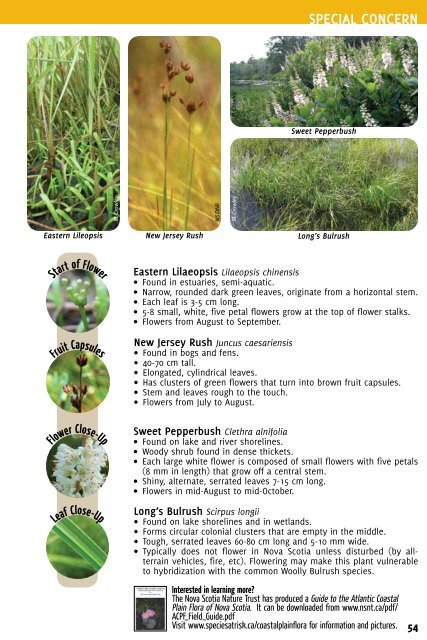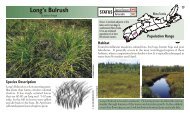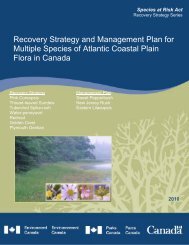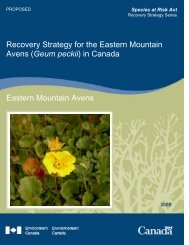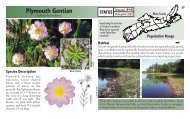Healthy Lakes and Wetlands For Tomorrow - Species at Risk
Healthy Lakes and Wetlands For Tomorrow - Species at Risk
Healthy Lakes and Wetlands For Tomorrow - Species at Risk
Create successful ePaper yourself
Turn your PDF publications into a flip-book with our unique Google optimized e-Paper software.
SPECIAL CONCERN<br />
M. Crowley<br />
NS DNR<br />
M. Crowley M. Crowley<br />
Sweet Pepperbush<br />
Eastern Lileopsis New Jersey Rush Long’s Bulrush<br />
Start of Flower<br />
Eastern Lilaeopsis Lilaeopsis chinensis<br />
• Found in estuaries, semi-aqu<strong>at</strong>ic.<br />
Narrow, rounded dark green leaves, origin<strong>at</strong>e from a horizontal stem.<br />
•<br />
• Each leaf is 3-5 cm long.<br />
• 5-8 small, white, five petal flowers grow <strong>at</strong> the top of flower stalks.<br />
• Flowers from August to September.<br />
Fruit Capsules<br />
Flower Close-Up<br />
New Jersey Rush Juncus caesariensis<br />
• Found in bogs <strong>and</strong> fens.<br />
• 40-70 cm tall.<br />
• Elong<strong>at</strong>ed, cylindrical leaves.<br />
• Has clusters of green flowers th<strong>at</strong> turn into brown fruit capsules.<br />
• Stem <strong>and</strong> leaves rough to the touch.<br />
• Flowers from July to August.<br />
Sweet Pepperbush Clethra alnifolia<br />
• Found on lake <strong>and</strong> river shorelines.<br />
Woody shrub found in dense thickets.<br />
•<br />
Each large white flower is composed of small flowers with five petals<br />
•<br />
(8 mm in length) th<strong>at</strong> grow off a central stem.<br />
• Shiny, altern<strong>at</strong>e, serr<strong>at</strong>ed leaves 7-15 cm long.<br />
• Flowers in mid-August to mid-October.<br />
Leaf Close-Up<br />
Long’s Bulrush Scirpus longii<br />
• Found on lake shorelines <strong>and</strong> in wetl<strong>and</strong>s.<br />
<strong>For</strong>ms circular colonial clusters th<strong>at</strong> are empty in the middle.<br />
•<br />
Tough, serr<strong>at</strong>ed leaves 60-80 cm long <strong>and</strong> 5-10 mm wide.<br />
•<br />
Typically does not flower in Nova Scotia unless disturbed (by all-<br />
•<br />
terrain vehicles, fire, etc). Flowering may make this plant vulnerable<br />
to hybridiz<strong>at</strong>ion with the common Woolly Bulrush species.<br />
Interested in learning more<br />
The Nova Scotia N<strong>at</strong>ure Trust has produced a Guide to the Atlantic Coastal<br />
Plain Flora of Nova Scotia. It can be downloaded from www.nsnt.ca/pdf/<br />
ACPF_Field_Guide.pdf<br />
Visit www.species<strong>at</strong>risk.ca/coastalplainflora for inform<strong>at</strong>ion <strong>and</strong> pictures.<br />
54


